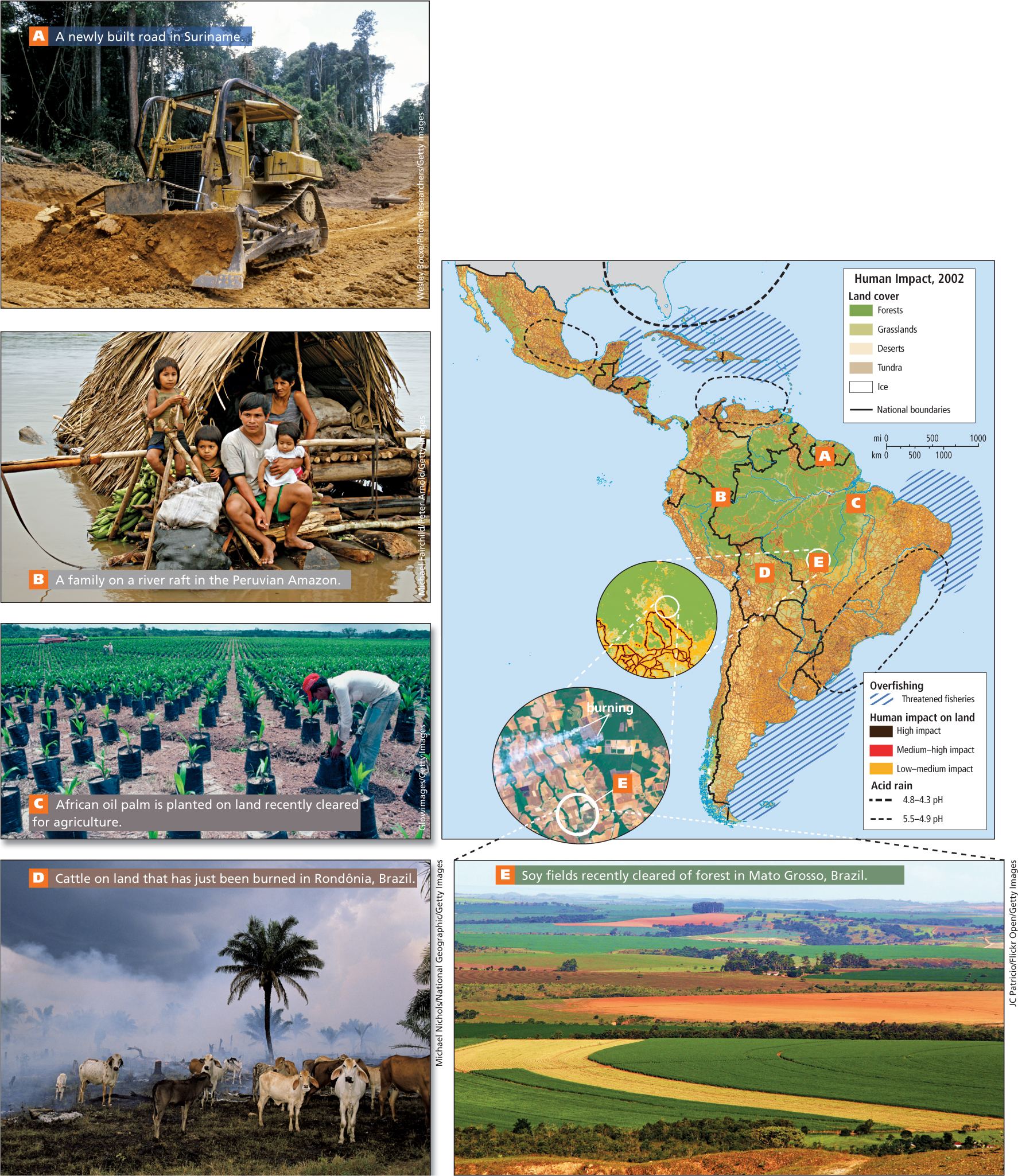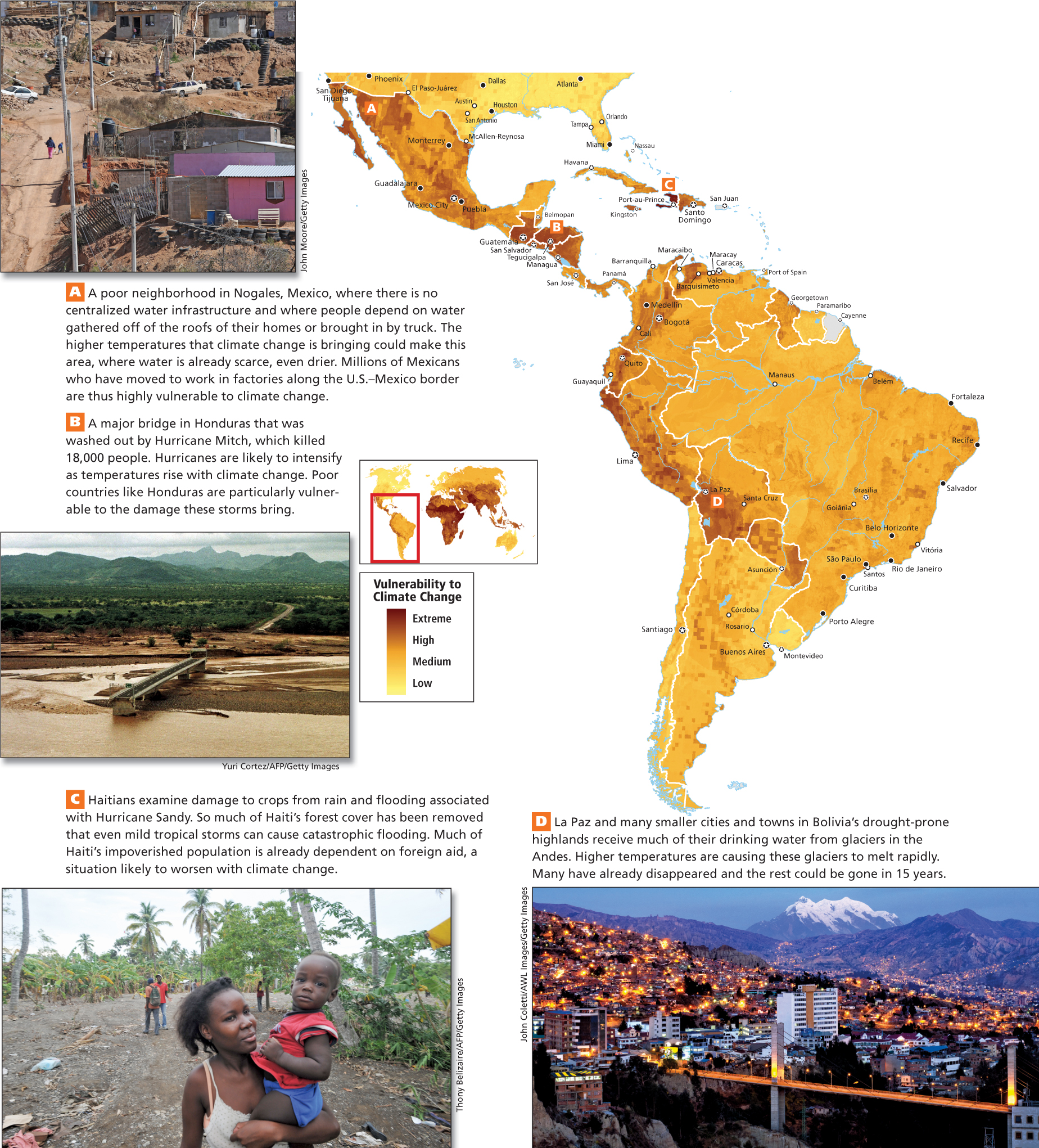3.3 ENVIRONMENTAL ISSUES
GEOGRAPHIC INSIGHT 1
Environment: Deforestation in this region contributes significantly to global climate change through the removal of trees, which as living plants naturally absorb carbon dioxide, a greenhouse gas. Once the trees are cut or burned, they release large amounts of carbon dioxide into the atmosphere. Additionally, despite the region’s overall abundant water resources, some areas are experiencing a water crisis related to climate change, inadequate water infrastructure, and intensified use of water.
Environments in Middle and South America have long inspired concern about the use and misuse of the Earth’s resources. Millennia before Europeans arrived in this region, human settlements in the Americas had major environmental impacts. However, today’s impacts are particularly severe because both population density and per capita consumption have increased so dramatically. Moreover, local environments now supply global demands.
Tropical Forests, Climate Change, and Globalization
A period of rapid deforestation that has had global repercussions began in the 1970s in Brazil with the construction of the Trans-
118
Middle and South American rain forests are being diminished by multiple human impacts (Figure 3.8). One of the biggest impacts is caused by the clearing of land to raise cattle and grow crops such as soybeans (for animal feed), sugarcane (for ethanol), and African oil palm (for cooking oil) (see Figures 3.8C–

THINKING GEOGRAPHICALLY
Use the Photo Essay above to answer these questions.
Question 3.1
BUU2SJoIs5yPlpSoSK9+u49qJV/77fSF0mQUMpFxzYWscK3XZaGH1XzWa6fXme008DHfaBv6Tuiraz0+GkF5yuVKqrw2Y+eB64B6cvYbuXTmyiSTQuestion 3.2
H9nEMvqTkGAnVJRxIEGjoPjhSZVL9Hm5I/j0Gf8fvtn/CPSIJpEbEtsT4689XebotHosgwxIKPqA4VnsEtgXTLrrdnbxT056XX702S2GjrIsEkxjMf9raxIQ/a5OFeVq1fszzkikfNmzWNB5Question 3.3
2VfGtvH0YIgDgLYbxYEtNHWPGUQytxRRXexNQBaCdkM+xLU37DnTzUm3RrdOduK4cZjBFu9WW+/4uTLyIiy45y3JzA1ipzklsyfR9hmNReSRWlNYHardwood logging and the extraction of underlying minerals, including oil, gas, and precious stones, also contribute to deforestation. Investment capital in logging industries is increasingly coming from Asian multinational companies that have turned to the Amazon forests after having logged as much as 50 percent of the tropical forests in Southeast Asia. The access roads that have been built to support these activities help accelerate deforestation by opening new forest areas to migrants. The governments of Peru, Ecuador, and Brazil encourage impoverished urban people to occupy cheap land along the newly built roads (see Figure 3.8A), and provide chainsaws to the settlers to help remove the trees. However, the settlers have had a difficult time learning to cultivate the poor soils of the Amazon. After a few years of farming, they often abandon the land, now eroded and depleted of nutrients, and move on to new plots. Ranchers sometimes then buy the worn-
While Middle and South America contribute significantly to global warming by adding CO2 to the Earth’s atmosphere, many people in this region are particularly vulnerable to the increasing threats of climate change. Figure 3.10 illustrates several such cases: shortages of clean water brought on by intensifying droughts and glacial melting; vulnerability to rising sea levels; and the effects of increasingly violent storms.
There is now an international effort to combat climate change by preserving the world’s remaining forests—
Environmental Protection and Economic Development
In the past, governments in the region argued that economic development was so desperately needed that environmental regulations were an unaffordable luxury. Now, though, these governments are beginning to embrace both economic development and environmental protection. One example of this new approach is ecotourism.
Ecotourism Many countries are now trying to earn money from the beauty of still-

ecotourism nature-
Ecotourism has its downsides, however. Mismanaged, it can be similar to other kinds of tourism that damage the environment and return little to the surrounding community. While the profits of ecotourism can potentially be used to benefit local communities and environments, the profit margins may be small.
VIGNETTE
Puerto Misahualli, a small river boomtown in the Ecuadorian Amazon, is currently enjoying significant economic growth. Its prosperity is due to the many European, North American, and other foreign travelers who come for experiences that will bring them closer to the now-
The array of ecotourism offerings can be perplexing. One indigenous man offers to be a visitor’s guide for as long as desired, traveling by boat and on foot, camping out in “untouched forest teeming with wildlife.” His guarantee that they will eat monkeys and birds does not seem to promise the nonintrusive, sustainable experience the visitor might be seeking. At a well-
By contrast, the solar-
The Water Crisis
Although Middle and South America receive more rainfall than any other world region and have three of the world’s six largest rivers (in volume), parts of the region are experiencing water crises. Most of the factors causing the water crises are induced by humans, who in turn are now exposed to a variety of water-

THINKING GEOGRAPHICALLY
Use the Photo Essay above to answer these questions.
Question 3.4
Fk792pKoEjEnj/4xzJX0cL/4c6b/LgASBWtKr7kVrzjVFE0nI3K6ApVEfSGTkRDHetCRLBVH1tEsm2d95XbwLx01wGOzi3Pq+WaeVRewDQMWJIXBPJ7j6ok1JFgkjQqrBjDbbSxnFf4RPBs5q1P/9Q6EhEwV8smrIjrAKkEl26A=Question 3.5
XFMK1QvnxRaexJBhFBDvhXGdf49KUuyXE9jqbArRNKRjUUIPbccwlDWAWbXTZVbFSNC6EfSwDnOVotuIuI5Ma37meCGkg3xF52RO5aL2akwuImjwpWutfw==Question 3.6
9dD82pUEEydvPUYaLgTr3Xg07yF2gVQChh2WMIWgWckZdRYg+fDn1cJa9OytJVpSfJYrBn3NhC0bCihFkFL0qJ6l+m3kaZ0viqB2SPtL2gKQSXMZ8pFPmXbwDuv97DQ1KEeOFQEqU+cL5KHXIkXjCSxy7334XfZ8Nd+zyuSsBg2go+29VBTuWiK+6tCjTbWdaI6CZ16Ojlw=Question 3.7
c/2ve0DENDpjB3CBjW4UnHnYPiR0LHp0vOUpYTOq3nVIQPcP70Q1EYJksyTz94E/KqfH/CoLvcV8Abpq5aggi7u2NgmPLyGq3jhCC9wPCxAJ+5g90rx0brXdUqM=Lax environmental policies have allowed industries and cities to pollute both air and water with few restraints. Waterways along the Mexican border with the United States are polluted by numerous factories set up to take advantage of NAFTA-
Rapid urbanization, combined with corruption, inadequate investment, and misguided policies, has left many people without access to clean water or sanitation. In some of the largest cities, the water infrastructure is so inadequate that as much as 50 percent of the fresh water is lost because of leaky pipes (see Figure 3.10A). Often as much as 80 percent of the population has no access to decent sanitation. Toilets are sometimes entirely lacking, leaving people to relieve themselves on the city streets. This poses a major health hazard, and as local water resources become too polluted to be drinkable, many cities must bring in potable water from distant areas.
Behind these immediate problems lie systemic policy failures and inadequate planning, such as that in Cochabamba, Bolivia (discussed in Chapter 1). There, efforts to improve the city’s inadequate water supply system focused on “marketizing” the water system. The water supply, long thought of as a public resource, was sold to a group of foreign corporations led by Bechtel of San Francisco, California. The hope was that Bechtel, in return for profits, would make investments in infrastructure that Cochabamba’s notoriously corrupt water utility would not make. Unfortunately, Bechtel, unfamiliar with the actual living conditions of the majority of its citizens, immediately increased water prices to levels that few urban residents could afford, while doing little to improve water supply or delivery systems. At one point Bechtel even charged urban residents for water taken from their own wells and rainwater harvested off their roofs! Popular protests forced Bechtel to abandon Cochabamba’s water utility, which remains plagued by corruption and an inadequate infrastructure.
ON THE BRIGHT SIDE
Alternatives to Deforestation
Ecotourism is now the most rapidly growing segment of the global tourism and travel industry, which by some measures is the world’s largest industry, accounting for $3.5 trillion in annual expenditures. Many Middle and South American nations also have spectacular national parks that can provide a basis for ecotourism. As an alternative to deforestation, development based on ecotourism has the potential to preserve this region’s biodiversity, reduce emissions of greenhouse gases, and provide less affluent and indigenous people with a chance to use their skills to teach tourists.
THINGS TO REMEMBER
GEOGRAPHIC INSIGHT 1
Environment Deforestation in this region contributes significantly to global climate change through the removal of trees, which as living plants naturally absorb carbon dioxide, a greenhouse gas. Once the trees are cut or burned, they release large amounts of carbon dioxide into the atmosphere. Additionally, despite the region’s overall abundant water resources, some areas are experiencing a water crisis related to climate change, inadequate water infrastructure, and intensified use of water.
121
122
One of the biggest impacts on rain forests is the clearing of land to raise cattle and grow crops.
Hardwood logging and the extraction of underlying minerals, including oil, gas, and precious stones, are also contributing to deforestation.
Governments in the region are beginning to embrace both economic development and environmental protection. One example of this new approach is ecotourism.
Lax environmental policies in much of Middle and South America have allowed industries and cities to pollute both air and water with few restraints.